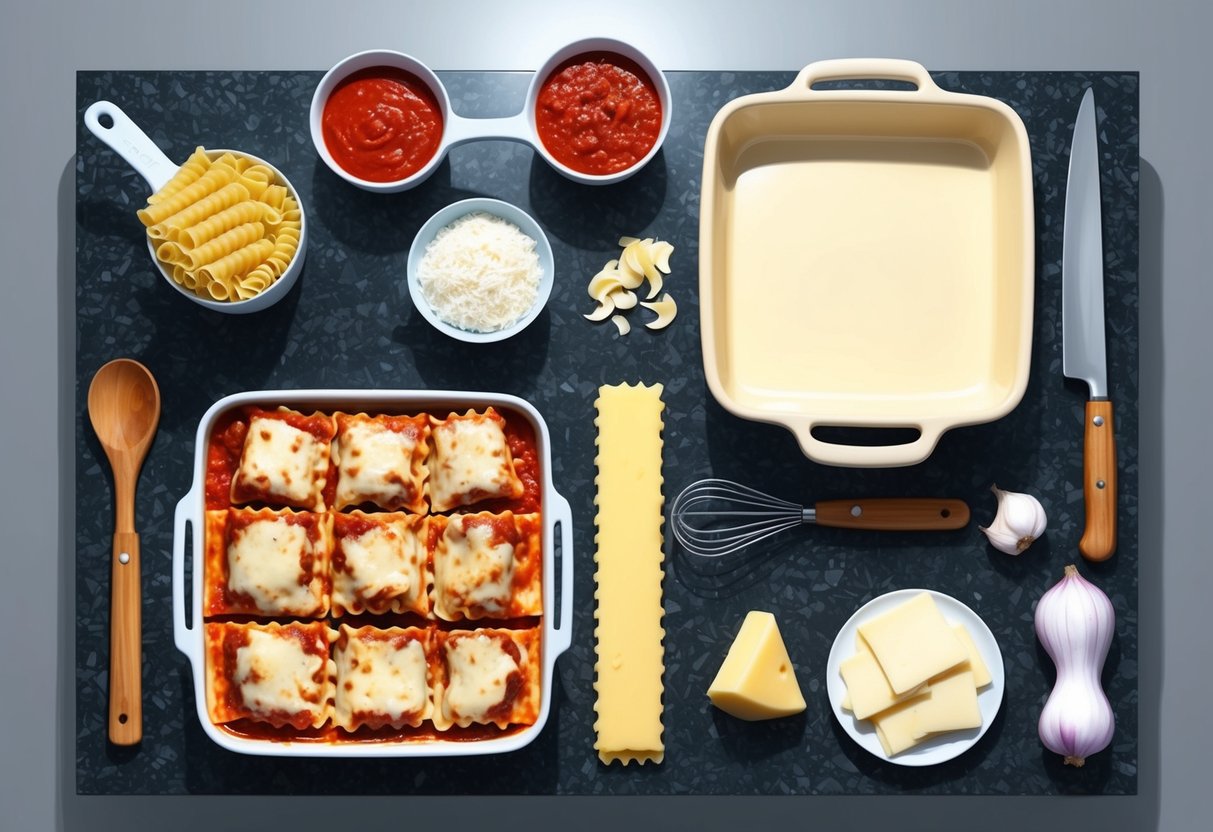
Handling and Precooking Lasagna Pasta
Preparing lasagna noodles correctly prevents them from sticking and ensures even baking.
When using dry lasagna, boil them until just barely tender (al dente), then layer them with sauce to finish cooking in the oven.
After boiling, rinse with cold water and lay noodles flat, preferably on a kitchen towel, to avoid clumping.
No-boil noodles eliminate the boiling step.
They should be layered directly with a generous amount of sauce, as the liquid is critical for full hydration.
If the sauce is too thick, adding a small amount of water or broth can help the pasta cook through evenly.
When using fresh pasta, cutting sheets to fit the pan is recommended.
These require little to no precooking; a few seconds in hot water suffices, or they can be used straight if rolled thin enough.
Careful handling of fresh sheets keeps them from tearing, especially when assembling multiple layers.
Preparing the Meat Sauce
A rich, well-balanced meat sauce forms the foundation of restaurant-quality lasagna.
Slow simmering brings out deep, layered flavors, while the right combination of meats and aromatics ensures both richness and complexity.
Classic Bolognese and Ragu
Classic lasagna typically relies on a traditional Bolognese or ragu, both of which create a savory base.
The process starts by finely chopping onions, carrots, and celery, then sautéing them in olive oil for a fragrant foundation.
Minced garlic and a touch of nutmeg add warmth and depth.
Ground beef is often combined with pork, such as Italian sausage or pancetta, to add extra flavor and fat.
The meat is browned thoroughly, allowing bits to caramelize for a richer sauce.
Tomato paste, crushed tomatoes, and a splash of red wine are added for body and acidity.
Simmering the sauce slowly—often for at least an hour—lets flavors meld and intensifies the sauce.
Milk or cream is sometimes stirred in near the end to soften the acidity of the tomatoes and add creaminess.
Meat Combinations and Flavor Enhancers
Using a blend of meats, such as lean ground beef and Italian sausage, brings both richness and complexity.
Pancetta or finely diced bacon can contribute a subtle smokiness and depth.
Consider using an 80/20 blend of ground beef to balance fat and flavor.
Aromatic enhancers play an essential role.
Fresh garlic is sautéed briefly to avoid bitterness.
Onion, carrot, and sometimes celery (the classic soffritto trio) add both sweetness and umami.
A dusting of freshly grated nutmeg provides warmth that is characteristic of authentic Bolognese.
A splash of red wine or beef broth elevates the dish further.
For added flavor, bay leaves or a pinch of dried Italian herbs (oregano, basil) can be included.
Letting the sauce rest before layering in the lasagna can intensify the flavors, as seen in some top-rated lasagna recipes.
Mastering Bechamel and Ricotta Mixtures
Balancing a smooth béchamel sauce with a rich ricotta filling is key for layering flavors and textures in lasagna.
Technique matters for both, especially to prevent a watery texture or bland taste.
How to Make a Creamy Béchamel Sauce
Béchamel sauce sets the foundation for a velvety, indulgent bite.
Begin by melting butter in a saucepan over medium heat.
Whisk in an equal amount of all-purpose flour, cooking for about two minutes to form a pale roux.
Slowly add warm milk while whisking continuously to eliminate lumps.
Cook for 5 to 7 minutes, stirring often until the sauce thickens enough to coat the back of a spoon.
For deeper flavor, season with salt, white pepper, and a touch of freshly grated nutmeg.
Aim for a sauce that is thick but still fluid so it can spread evenly between pasta layers.
If the béchamel becomes too thick, whisk in a splash of milk to adjust the consistency.
For additional guidance and ratios, refer to this classic béchamel approach.
Creating the Perfect Ricotta Filling
Ricotta filling contributes creaminess and flavor, complementing both the meat and the béchamel.
Start with whole milk ricotta for the richest texture.
Drain off excess liquid to avoid a runny consistency in the finished dish.
In a mixing bowl, combine the ricotta with one or two eggs to add structure and ensure a cohesive layer.
Add grated cheese, such as Parmigiano-Reggiano or pecorino, for umami and a bit of saltiness.
Many recipes include chopped fresh parsley or a bit of nutmeg to brighten the filling.
Mix until smooth but avoid overworking the ingredients.
Taste and adjust with salt and pepper, then spread evenly over your noodles between layers.
For a detailed step-by-step breakdown, reference this ricotta-based lasagna recipe.



